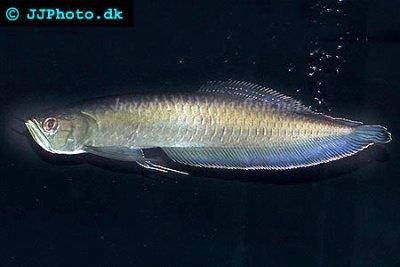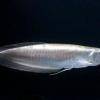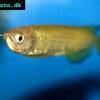Black arowana - Osteoglossum ferreirai
Scientific name: Osteoglossum ferreirai
Common name: Black arowana
Family: Osteoglossidae
Usual size in fish tanks: 50 - 100 cm (19.69 - 39.37 inch)
014
Recommended pH range: 5 - 7
Recommended water hardness: 0 - 12°N (0 - 214.29ppm)
0°C 32°F30°C 86°F
Recommended temperature range: 24 - 30 °C (75.2 - 86°F)
The way how these fish reproduce: Spawning
Where the species comes from: South America
Temperament to its own species: peaceful
Temperament toward other fish species: peaceful
Usual place in the tank: Top levels
Origin
The Black arowana originates from South America where it inhabits slow moving waterways around the basins of the River Negro. The main countries that these fish are to be found are Brazil, Colombia and Guyana.
Short description
The Black arowana like all of the arowana species is not a fish for novice fish keepers. They require large aquariums and tlc (tender, loving care) to keep them happy, they are a peaceful species though and become quite tame. They are a freshwater bony fish and belong to the family of Osteoglossidae. Adult specimens can reach an overall length of 35 inches hence the need for a large aquarium with plenty of swimming space. In the wild they tend to occupy the higher levels of water as they predate on insects, small mammals etc. and this is replicated in the aquarium.
Juvenile specimens will display yellow markings over a black background colour but as the fish matures these markings will disappear and they display an adult colouration of grey with a bluish tint.
Lifespan
If cared for correctly the average lifespan of the Black arowana can be up to 20 years so these fish are a long term commitment.
General care
As mentioned above these fish require a large aquarium when mature specimens so always bear this in mind if you are considering purchasing juvenile specimens. The minimum size for the aquarium should be at least 8 feet ( 240 cm) in length and 4 feet (120 cm) width with a depth of at least 2 feet (60 cm). They are a high waste producer so an excellent filtration system will be required to keep the water quality high and this will need to be backed up with regular water changes of at least 25%, not a small task with such a large water volume. The water temperature should range between 24 - 30 °C (75.2 - 86°F) and set the pH range between 5.0 - 7.0. Arowana prefer black water conditions so there are many commercial additives available to help with this but make sure that you read the instructions for dosage and adhere to these according to the water volume that your aquarium contains. Decoration of the aquarium is not required as the Black Arowana will spend most if it’s time at the higher water levels but if you wish to add some ornaments purely for aesthetics, these should not be sharp and have well rounded edges.
Feeding
Arowana prefer live foods to predate on but this can cause problems in the aquarium, adding feeder fish can often introduce diseases if the fish are hosts so this practice is best avoided if possible. In the wild they do predate on insects so the use of crickets as part of the diet is ideal as is shrimps etc. for more meaty foods. There are commercial pellets available on the market which you can use for the staple diet but you may need to introduce these slowly until the Arowana realises that they are a food source and does not refuse them.
Sexing
There is no reliable way to sex the Black arowana, if you were to have an aquarium large enough to house a group they would pair off naturally but commercial breeders use large ponds so this is not practical for the home fish keeper.
Breeding
There are no reliable reports of the Black Arowana breeding in the aquarium, this would also not be practical due to the size of the aquarium required. It is known they are paternal mouthbrooders with the male taking the eggs into his mouth once fertilised and caring for the fry when they have hatched. The eggs are quite large, averaging out at 0.5 “ in diameter and the female deposits them on the substrate ready for the male to fertilise.
Picture
Bought by aqua-fish.net from jjphoto.dk


 Silver
Silver  Gulf
Gulf  Saratoga
Saratoga